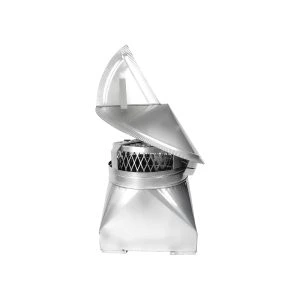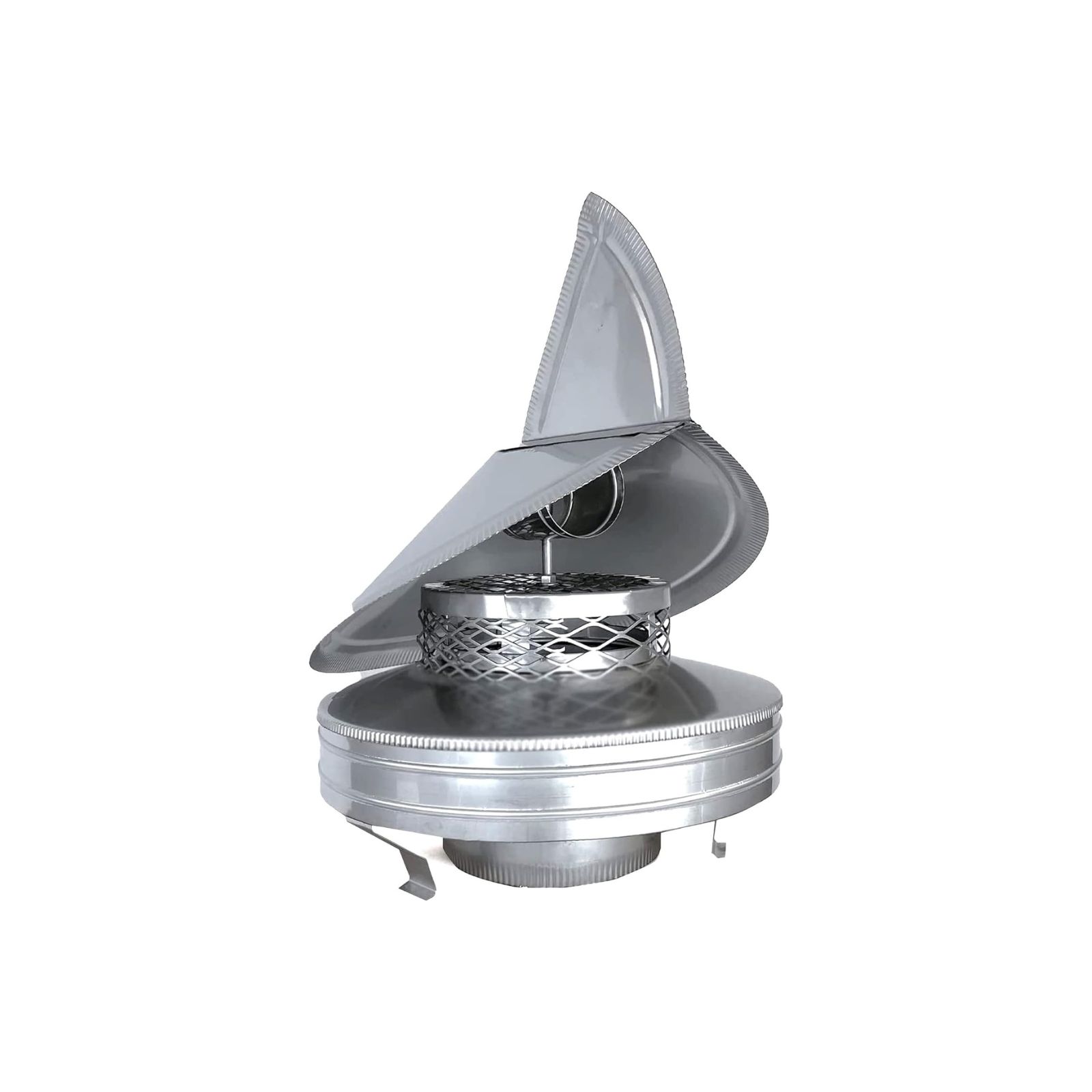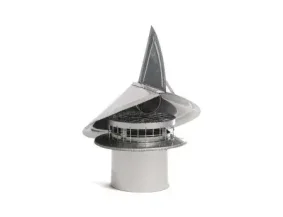Wind Directional Chimney Caps - Stop Downdrafts & Boost Efficiency 30%
Professional-grade wind directional chimney caps that eliminate costly downdrafts, prevent smoke backflow, and improve heating efficiency. Made in USA with lifetime warranty.
What Are Wind Directional Chimney Caps?
Wind directional chimney caps are advanced rotating chimney toppers that automatically align with wind direction to prevent downdrafts and improve draft performance. Unlike standard chimney caps, these innovative caps use wind power to create a venturi effect that enhances updraft by up to 40%.
These caps feature a spinning turbine design with wind vanes that keep the opening positioned away from incoming wind. This prevents wind from pushing down your chimney flue and causing smoke to enter your home.
Top 5 Benefits of Wind Directional Chimney Caps
Eliminate Downdrafts
Prevents wind-driven downdrafts that cause smoke, odors, and cold air to enter your home. Essential for homes in windy areas.
Lower Energy Costs
Reduce heating bills by 15-30% through improved combustion efficiency and eliminated heat loss from downdrafts.
Boost Efficiency 30%
Improves heating efficiency by creating stronger updrafts, leading to better combustion and reduced heating costs.
Extend Chimney Life
Prevents moisture damage and corrosion, extending the lifespan of your entire chimney system.
Weather Protection
Shields chimney from rain, snow, debris, and animals while maintaining optimal airflow in all conditions.
Best Wind Directional Chimney Caps 2025

Stainless Steel Wind Directional Cap
Premium Choice - Marine-grade stainless steel construction resists corrosion and provides decades of service.

Air Cooled Wind Directional Cap
For Air Cooled Chimneys - Designed specifically for double-wall air cooled chimney systems.

Stainless Steel Wind Directional Cap
Premium Choice - Marine-grade stainless steel construction resists corrosion and provides decades of service.
How Wind Directional Chimney Caps Work
Wind directional chimney caps operate on the venturi principle. As wind flows over and around the rotating cap, it creates a low-pressure area above the chimney opening. This pressure differential pulls smoke and gases up through the flue more effectively than natural draft alone.
The wind vane system automatically rotates the cap to keep the opening positioned away from prevailing winds, preventing downdrafts regardless of wind direction changes.
Particle Legend
Air-Cooled vs Non-Air-Cooled Chimneys
Choosing the right chimney cap depends on whether you have an air-cooled or non-air-cooled chimney system. Air-cooled chimneys require special caps that allow cooling airflow between the metal layers, while non-air-cooled chimneys need solid caps designed to handle heat retention.
Professional Installation Guide
Essential Tools & Safety
Before starting, gather these tools: sturdy ladder extending 3 feet above your roof, work gloves, power drill or screwdriver, tape measure, pencil, and paper. Safety first: Have someone hold the ladder and never work alone on the roof.
Step-by-Step Measuring Instructions
Single Flue Chimneys (Most Common)
- Extended Round Flues: Measure outside diameter of pipe extending above crown
- Extended Square/Rectangle: Measure length and width of outside edges of flue tile
- Flush Flues: Measure inside dimensions if flue is flush with crown
Air Cooled vs Non-Air Cooled Systems
- Air Cooled: Look for visible air space between inner and outer walls. Measure both inside diameter (for cap fit) and outside diameter (for adapter)
- Non-Air Cooled: Solid pipe with no visible air space. Measure outside diameter only
Multi-Flue Chimneys
- Measure length and width covering all flues from outermost edges
- Measure entire cement crown dimensions
- Measure height of tallest flue (cap must be 5+ inches above tallest flue)
- Account for 1.5-inch flanges when calculating total coverage needed
Professional Installation Steps
- Safety Setup: Position ladder securely with spotter, use proper safety equipment
- Measurement Verification: Double-check all measurements on-site before installation
- Surface Preparation: Ensure chimney surface is clean, dry, and structurally sound
- Cap Positioning: Center cap properly, ensuring adequate clearance for rotation
- Secure Installation: Use appropriate fasteners for your chimney type (masonry screws for crown, clamps for pipes)
- Seal Connections: Apply high-temperature silicone caulk around crown-mounted caps
- Function Test: Verify cap rotates freely and wind vane operates correctly
- Final Inspection: Check all connections and ensure no gaps for debris entry
Common Sizing Guidelines
Standard Masonry Sizes: Common clay flue tiles include 8"×8", 8"×13", 13"×13", 8"×17", and 13"×17". Most caps accommodate a 1-inch range (e.g., 8"×8" cap fits 7.5" to 9.5" flues).
Round Metal Pipe Sizes: Available from 5" to 14" diameter. Wind directional caps typically fit outside diameter with clamp systems.
Maintenance & Care Guide
Essential Annual Maintenance
Wind directional chimney caps require regular maintenance to ensure optimal performance and prevent dangerous malfunctions.
Cleaning Schedule
- Monthly During Use: Visual inspection for debris buildup
- Mid-Season: Remove leaves, twigs, and snow accumulation
- Annual Deep Clean: Complete disassembly and thorough cleaning
- Post-Storm: Check for damage after severe weather
Creosote Buildup Prevention
Critical Warning: Creosote buildup on rotating mechanisms can freeze the cap in position, potentially funneling wind directly down your chimney and filling your home with smoke.
- Burn Seasoned Hardwood: 18% moisture content or less reduces creosote production
- Maintain Hot Fires: Higher combustion temperatures minimize condensation
- Annual Professional Cleaning: Remove creosote deposits before they harden
- Apply Anti-Seize Compound: Use Bostik High Temp Stainless Anti-Seize on rotating brackets annually
Step-by-Step Cleaning Process
- Safety Preparation: Ensure fireplace is completely cool, use proper ladder safety
- Initial Inspection: Check for creosote buildup, rust, loose screws, or damaged components
- Screen Cleaning: Use stiff wire brush to remove soot and debris from mesh screens
- Mechanism Cleaning: Clean rotating parts with vinegar solution for light buildup
- Heavy Buildup: For glazed creosote, professional removal may be required
- Lubrication: Apply high-temperature anti-seize compound to moving parts
- Function Test: Ensure cap rotates freely and wind vane operates correctly
Warning Signs Requiring Immediate Attention
- Cap Won't Rotate: Indicates creosote freeze or mechanical failure
- Smoke Entering Home: May indicate cap stuck in wrong position
- Visible Tar-Like Buildup: Stage 2-3 creosote requiring professional cleaning
- Reduced Draft Performance: Screen may be clogged with debris
- Rust or Corrosion: Structural integrity may be compromised
Professional Recommendation: If your chimney produces significant creosote, remove and clean the cap every time you sweep the chimney to prevent dangerous malfunctions.
Why Choose ChimCare Wind Directional Chimney Caps?
- Made in USA - Superior craftsmanship and quality control
- Lifetime Warranty - Confidence in our product durability
- Professional Grade - Heavy-duty construction for extreme weather
- Expert Support - Technical assistance for proper sizing and installation
- Fast Shipping - In-stock items ship within 1-2 business days
Customer Reviews from Amazon
“Was unable to have a fire on windy days. Found this very easy to install. Working perfectly—no more back puffing. Does increase the draft so I’m sure more heat is being pulled out. But love this anyway.”
“We were getting such a draft from our fireplace (gas log in natural fireplace). Debated on this cap because of the price but it was such an improvement over last winter, probably paid for itself in saved energy costs. Installation was done by a roofer but was simple enough for a handy person who didn’t mind going up on the roof. Had to have someone measure the flue before ordering. Would definitely recommend if you’re having a draft issue!”
“Easy to install, but a little small to easily fit around 13 × 13 tile chimney lining. Still, rotates with the wind and prevents smoke from being blown down the chimney on a windy day.”
“I liked it being stainless steel and having a screen in place to keep birds and rodents out of the chimney. Just slid inside of opening and solved the problem on downdrafts on windy days. It also helped on starting the stove up to add better smoke draw.”
“Product is built with ‘Pride’ Workmanship. Should last for years to come.”
“Nothing…it met and continues to meet advertised standard. We now have a fully functional fireplace. Happy customer.”
“Blows with the wind to aim the smoke away from the house.”
“We live at the bottom of a hill by the water. Cool evenings (when I want a fire) we have cold air tumbling down the hill and my chimney. We once filled the house with smoke by running the kitchen exhaust fan. This gizmo has worked so far to reduce the prospect of a repeat of that profanity laced event.”
“If you live in a high wind area this is a must have! Let’s see how she withstands the SW Mt breeze, not more like strap everything down!!!”
“This cap is exactly what we needed. Perfect fit! Quality made, arrived on time. If you’re looking for a wind deflection this cap did it for us.”
Compare Wind Directional Chimney Caps
| Feature | Stainless Steel Cap | Air-Cooled Cap | Non-Air-Cooled Cap |
|---|---|---|---|
| Best For | Masonry chimneys with clay flue tiles | Double-wall metal chimneys | Single-wall metal chimneys |
| Flue Type | Square / Rectangle | Round (with air gap) | Round (solid pipe) |
| Material | 304 Stainless Steel | 304 Stainless Steel | 304 Stainless Steel |
| Rotating Design | ✓ Yes | ✓ Yes | ✓ Yes |
| Warranty | Lifetime | Lifetime | Lifetime |
| Shop Now | Shop Now | Shop Now |
Frequently Asked Questions
Do wind directional chimney caps work in all wind conditions?
Yes, wind directional caps work in light to strong winds. The rotating design automatically adjusts to changing wind directions. However, they only address wind-related downdrafts, not issues caused by chimney top pressurization or air inversion.
How much maintenance do wind directional caps require?
We recommend cleaning your rotating cap at least once a year to remove smoke deposits from the spinning mechanism. Apply high-temperature anti-seize compound to moving parts annually. If you burn wood frequently, check monthly during heating season to make sure the cap rotates freely.
Can I install a wind directional cap myself?
Yes, if you're comfortable working on your roof and have basic DIY skills. You'll need a sturdy ladder, drill, and proper safety equipment. That said, professional installation is recommended if you have a steep roof or aren't sure about proper sizing and placement.
What's the difference between air-cooled and non-air-cooled caps?
Air-cooled caps fit double-wall metal chimney pipes that have a visible air space between the inner and outer walls. Non-air-cooled caps fit solid single-wall pipes with no air space. If you can see or feel an air gap between the pipe walls when you look at your chimney from the roof, you need the air-cooled version.
Will a wind directional cap fix all my smoke problems?
Wind directional caps solve smoke problems caused by wind pushing air down your chimney. If your smoke issues happen even on calm days, the problem might be something else like a blocked flue, undersized chimney, or negative air pressure in your home. Contact us if you're not sure what's causing your smoke problems.
How long do wind directional chimney caps last?
Our 304 stainless steel wind directional caps are built to last a lifetime with proper maintenance. That's why we back them with a lifetime warranty on materials and workmanship. The rotating mechanism may need occasional lubrication, but the cap itself won't rust or corrode.

 We Ship Anywhere USA & Canada
We Ship Anywhere USA & Canada

